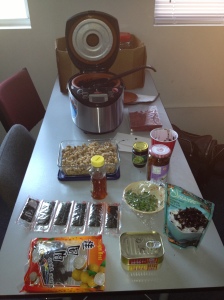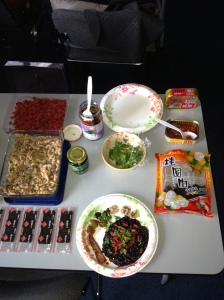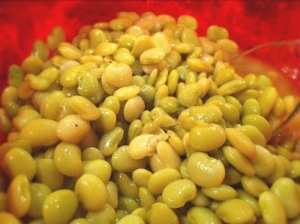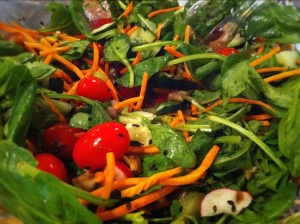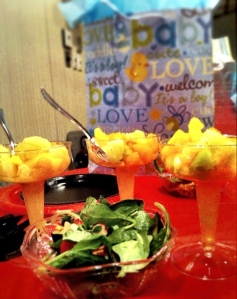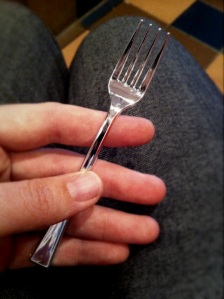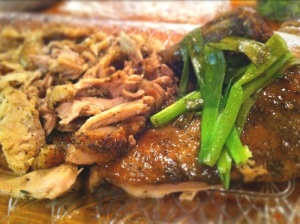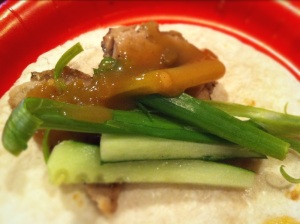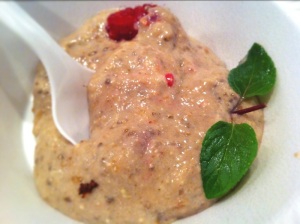Today’s class was truly a holiday affair, with AS and AJ preparing a blood-nourishing Thanksgiving feast. This post covers both AS and AJ’s projects, as together they transformed our eating area into “Cafe Bu Xue” (or “Build Blood”), complete with candles and flowers. AS outdid herself by preparing a date appetizer, salad, pot roast and a couscous dish, while AJ brought it home with a raspberry tiramisu for the record books. This was, by all accounts, a huge treat…it’s been a long time since the whole class was so silent, everyone contentedly munching on this blood-building buffet.

Little eggs, big taste.
I must say, this meal contained a first for me: quail eggs. Everything is better miniature! Actually, two firsts: AS also brought in a jar of hibiscus blossoms in syrup designed for flavoring and garnishing cocktails. The craziest we could get with our cocktails in an academic setting was ginger ale, but it was still a beautiful sight! (I can vouch for their beauty in champagne, too, as I brought a jar of the blooms to our family Thanksgiving meal. Be prepared for about 1,000 “What IS that?!”‘s tossed your way, though!)

Fancying up a glass of ginger ale with a hibiscus blossom!
Feast your eyes on the menu–then go make yourself some blood-boosting goodness. As always, click on the pictures to see larger mouth-watering images!
Appetizer:
~ Festive Stuffed Medjool Dates – chockful of goodies

Medjool dates stuffed with sunshine.
~ Spinach, Chard, Kale & Roasted Beet Salad, topped off with Quirky Quail Eggs, Craisins, Walnuts and a Balsamic Vinaigrette drizzle
Entrée:~ Hearty Crock-Pot Roast; slow-roasted with Carrots, Field Peas, Pearl Onions & Baby Red Potatoes
~ Couscous with Cranberries, Almonds & Pine-Nuts

Couscous a la Xue
Dessert:~ Rascally Royal Raspberry Tiramisu & Sparkling “Ale” with Hibiscus Flowers
TCM Diagnosis: Blood Deficiency
In the “Western world”, Blood Deficiency, aka “Xue Xu”, correlates with anemia, but you don’t have to have a low blood count to have symptoms of blood deficiency. It’s usually caused by Spleen Qi deficiency (“Spleen is the mother of blood“) which reduces its ability to “T-n-T” (i.e. transform food into blood & energy, & transport it to the rest of the body). When blood becomes deficient, however, both the Heart & the Liver are affected as well (sing with me now: “Liver stores blood; Heart governs blood“). Various factors cause blood deficiency, including inappropriate diet/lifestyle, overwork (taxes the Spleen), holding in emotions, excess drinking/drug use (weakens Liver’s ability to store blood), menstrual disorders, post-partum blood loss, or genetic imbalances. There’s a wide range of symptoms since Xue Xu affects almost all systems in the body. Symptoms may include: palpitations, forgetfulness, poor memory, insomnia, shortness of breath, dizziness, fatigue, excessive dreaming, constipation, pale complexion, pale and dry, cracked lips, dry mouth, headache with lightheadedness, floaters, anxiety, numbness or tingling in limbs, dry skin/hair/nails, irregular/light menses; Tongue: pale; Pulse: thin or choppy. Chinese herbs used to treat symptoms of blood deficiency do so bynourishing and/or tonifying blood. Some of these include: Dang Gui: (Chinese Angelica root); Bai Shao (White Peony root); Long Yan Rou (Longan); Hong Zao/Da Zao (red/black dates); and Gou Qi Zi (Chinese Wolfberry).
Foods Used For Blood Deficiency:
Most of the iron in our diet comes from meat sources such as beef, liver (yes, liver!), oysters, chicken, eggs, etc., but yes – you can also nourish blood with a non-meat diet that’s rich in iron. These are just some of the foods that are believed to help blood deficiency: asparagus, grapes, potatoes, royal jelly, yams, berries (raspberries, blackberries, etc), squash, carrots, kale, spinach, beets, even grains! On the other hand, you need to avoid foods (in excess) that are cold, raw, damp or greasy (they damage the Spleen), as well as alcohol or drugs. Foods that nourish & tonify blood (such as beef, lamb, carrots, etc.) are considered ‘warming’ so they go very well during the late autumn & winter seasons – hence why we gravitate so much more towards stews and casseroles around the winter holidays. These warm, acrid & sweet flavors build up our Qi & Blood – if you’re feeling chilled to the bone, how about a nice bowl of hot marrow broth? Any of the warming methods (e.g. grilling, roasting, baking or simmering) work well as a way of preparing blood building dishes. And, in between your acupuncture treatments, you can apply acupressure to the same points we would needle to stimulate “Blee & Chud” (aka Qi & Blood) boosting effects: UB 17, UB 20, LVR 8 & SP 6.
References:
Macciocia, Giovanni. Foundations of Chinese Medicine
Kaptchuk TJ. The Web That Has No Weaver: Understanding Chinese Medicine.
Paul Pitchford. Healing With Whole Foods: Asian Traditions and Modern Nutrition
Jilin, Liu & Peck, Gordon. Chinese Dietary Therapy.
Ody, Penelope. The Chinese Herbal Cookbook: Healing Foods from East and West.
My Tried & True Easy Crock Pot Roast to Nourish Blood

Ingredients:
1 3-pound boneless chuck roast
2 tsps seasoning salt
2 tsps black pepper
3 bay leaves
3 cloves garlic, minced
1 onion, thinly sliced
¼ cup chopped celery
1 large carrot cut into ½” pieces
4 small baby red potatoes, washed & cubed
¼ cup frozen green peas
12 small pearl onions or shallots
3 or 4 beef bouillon cubes, crushed
½ cup water (or, better yet: red wine, extra oomph to boost that blood!)
1 tbsp vegetable oil
Directions:
Sprinkle roast on all sides with seasoning salt & black pepper. Put roast in deep dish with next 4 ingredients; cover & marinate overnight in refrigerator. Next day, allow to sit at room temperature for 10 minutes, then heat vegetable oil in skillet. Brown roast on all sides; drain oil but keep pan drippings (browning the meat makes the whole dish tastier and gives the pan juices an appetizing deep brown color). Sauté sliced onions & celery in pan drippings for 2 minutes. Place roast in a crock pot, and top with all ingredients except bouillon cubes. Dissolve bouillon cubes in ½ cup water (or red wine J ). Pour over roast. Cook on low setting for 8 hours. Allow to sit at room temperature for about 15 minutes before slicing; better yet, shred roast & let it soak up all that loving juices of the gravy!
Spinach, Kale, Chard & Roasted Beets salad
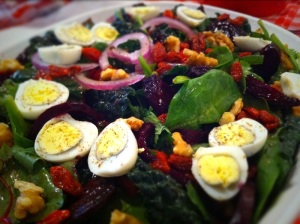
Ingredients:
1 tablespoon extra-virgin olive oil
Kosher salt, freshly ground pepper
1 bunch Lacinto kale, triple-washed; center ribs and stems removed, leaves cut into 1-inch squares
1 bunch Spinach (about 8 ozs), washed
1 bunch red chard, washed’ center ribs & stems removed; leaves cut into 1-inch squares
1/4 cup minced shallots/sliced red onions
3 medium beets (about 1 bunch), trimmed, washed & peeled; cut into small wedges
4 ounces feta/goat/bleu cheese, crumbled
2 tablespoons Balsamic Vinaigrette
4 Quail eggs, hard boiled (just as you would make boiled eggs), coarsely chopped
¼ cup dried cranberries (Craisins) or Goji berries
¼ cup walnuts/pecans
Directions:
Preheat oven to 375°. Grease shallow baking sheet with olive oil & arrange beets in 1 layer. Roast for about 20 minutes or until fork tender then allow to cool. Mix kale& spinach together. Drizzle with balsamic vinaigrette & fold gently to combine. Top with roasted beet wedges. Sprinkle with chopped shallots or red onions, cheese of choice, cranberries & nuts. Cover and chill, at least 3 hours.
~~~~
Rascally Royal Raspberry Tiramisu

Tiramisu
1 (12 oz.) bag white chocolate pieces
3 pkg. cream cheese, softened
2 pkg of Lady Fingers
2 pt. baskets fresh strawberries, stemmed, divided or other fresh berries
1 1/2 cups raspberries, rinsed and patted dry
2 Tablespoons granulated sugar
1/2 cup plus 3 tablespoons Chambord or other raspberry-flavored liqueur or ruby port
1/2 cup Raspberry coulis
2 cups heavy cream
Raspberry Coulis
2 cups raspberries (about 12 ounces), rinsed
3/4 cup simple syrup
1 1/2 Tablespoons lemon juice (fresh)
1/2 Tablespoon cornstarch
Simple Syrup
2 cups sugar
2 cups water
Raspberry Coulis
Bring the raspberries, syrup and lemon juice to a simmer in a medium saucepan over low heat. Simmer, stirring occasionally, until the berries are very soft, about 10 minutes.
Sprinkle the cornstarch over 2 teaspoons cold water and stir to dissolve. Pour into the simmering raspberry mixture. Cook, stirring, occasionally, until the sauce thickens, about 3 minutes.
Blend the mixture and then strain through a fine-mesh wire sieve into a medium bowl; discard the seeds. Cool completely, then cover and refrigerate until ready to use. (Freeze any leftover coulis in a plastic container for up to one month.)
Simple Syrup
Bring the sugar and water to a boil in a heavy medium saucepan over high heat. Reduce the heat to medium-low. Simmer, stirring until the sugar is completely dissolved, 6 to 8 minutes. Let cool completely. Transfer to an airtight container. Refrigerate until completely chilled, at least 4 hours.
1. To make filling, melt white chocolate chips in top of double boiler over hot, not boiling water. Stir until smooth.
2. In large mixer bowl, beat cream cheese until fluffy. Stir in melted chips. Whip cream to form soft peaks. Gradually whisk into cream cheese mixture, set aside.
3. Line bottom of a 11 x 8 x 3 -inch pan with lady finger halves, cut sides in.. Drizzle the remaining 1/4 cup Chambord over the lady fingers and cover with half of the coulis. Cover the berries with half of cream filling, gently spreading it into a smooth layer of the remaining whipped cream. Now, spread the other half of the lady fingers on top of that layer, and repeat adding the coulis , adding the other 1/4 cup of Chambord, the other half of the berry mixture, and the other half of the cream filling. Cover tightly with plastic wrap. Refrigerate for at least 2 hours and up to 1 and 1/2 days.
RASPBERRIES
Neutral , sweet and sour Organs: Liver and Kidney
Nourishes and cleans blood, regulate menstruation, treats anemia, treats excessive and frequent urination (esp at night) can be used to induce labor
**raspberry leaf**
Strengthen uterus, checks excessive menstrual flow, restrains bleeding generally, supports optimum hormonal patterns in pregnancy.
** *cream is made from cows’ milk
Neutral to cold, sweet, LU ST HT, earth
Support qi yin and blood, support LU,ST,HT and creates body fluids. Moistens intestines and skin detoxifies. Indication general qi and blood def, st yin def
***Cow milk cheese
Neutral to cool, sweet and sour. ST, SP,LU, LV. Wood and earth
Support and move qi, Nourish yin, laxative. Indication yin xu, esp lung yin xu, dryness in LI

Cross-section of beauty.
Posted by Lauren in
Blood deficiency and tagged
almonds,
beet,
blood deficiency,
bu xue,
carrots,
chard,
couscous,
cranberries,
crock pot,
dates,
egs,
hibiscus,
kale,
medjool,
peas,
pine nuts,
potatoes,
quail eggs,
raspberries,
raspberry,
roast beef,
salad,
spinach,
tiramisu,
xue xu |


